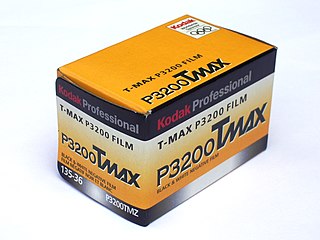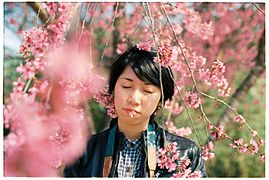
Film stock is an analog medium that is used for recording motion pictures or animation. It is recorded on by a movie camera, developed, edited, and projected onto a screen using a movie projector. It is a strip or sheet of transparent plastic film base coated on one side with a gelatin emulsion containing microscopically small light-sensitive silver halide crystals. The sizes and other characteristics of the crystals determine the sensitivity, contrast and resolution of the film. The emulsion will gradually darken if left exposed to light, but the process is too slow and incomplete to be of any practical use. Instead, a very short exposure to the image formed by a camera lens is used to produce only a very slight chemical change, proportional to the amount of light absorbed by each crystal. This creates an invisible latent image in the emulsion, which can be chemically developed into a visible photograph. In addition to visible light, all films are sensitive to X-rays and high-energy particles. Most are at least slightly sensitive to invisible ultraviolet (UV) light. Some special-purpose films are sensitive into the infrared (IR) region of the spectrum.

A rangefinder camera is a camera fitted with a rangefinder, typically a split-image rangefinder: a range-finding focusing mechanism allowing the photographer to measure the subject distance and take photographs that are in sharp focus. Most varieties of rangefinder show two images of the same subject, one of which moves when a calibrated wheel is turned; when the two images coincide and fuse into one, the distance can be read off the wheel. Older, non-coupled rangefinder cameras display the focusing distance and require the photographer to transfer the value to the lens focus ring; cameras without built-in rangefinders could have an external rangefinder fitted into the accessory shoe. Earlier cameras of this type had separate viewfinder and rangefinder windows; later the rangefinder was incorporated into the viewfinder. More modern designs have rangefinders coupled to the focusing mechanism so that the lens is focused correctly when the rangefinder images fuse; compare with the focusing screen in non-autofocus SLRs.

135 film, more popularly referred to as 35 mm film or 35 mm, is a format of photographic film used for still photography. It is a film with a film gauge of 35 mm (1.4 in) loaded into a standardized type of magazine – also referred to as a cassette or cartridge – for use in 135 film cameras. The engineering standard for this film is controlled by ISO 1007 titled '135-size film and magazine'.

Advanced Photo System (APS) is a discontinued film format for still photography first produced in 1996. It was marketed by Eastman Kodak under the brand name Advantix, by FujiFilm under the name Nexia, by Agfa under the name Futura and by Konica as Centuria.

Carl Zeiss AG, branded as ZEISS, is a German manufacturer of optical systems and optoelectronics, founded in Jena, Germany in 1846 by optician Carl Zeiss. Together with Ernst Abbe and Otto Schott he laid the foundation for today's multi-national company. The current company emerged from a reunification of Carl Zeiss companies in East and West Germany with a consolidation phase in the 1990s. ZEISS is active in four business segments with approximately equal revenue in almost 50 countries, has 30 production sites and around 25 development sites worldwide.

FUJIFILM Holdings Corporation, trading as Fujifilm, or simply Fuji, is a Japanese multinational conglomerate headquartered in Tokyo, Japan, operating in the realms of photography, optics, office and medical electronics, biotechnology, and chemicals.

In photography, reversal film or slide film is a type of photographic film that produces a positive image on a transparent base. Instead of negatives and prints, reversal film is processed to produce transparencies or diapositives. Reversal film is produced in various sizes, from 35 mm to roll film to 8×10 inch sheet film.

Velvia is a brand of daylight-balanced color reversal film produced by the Japanese company Fujifilm. The name is a portmanteau of "Velvet Media", a reference to its smooth image structure. The original incarnation of the film was called "Velvia for Professionals", known as RVP, a classification code meaning "Reversal/Velvia/Professional series". It is known for its extremely high level of color saturation and image quality.

Nikon Corporation, also known just as Nikon, is a Japanese multinational corporation headquartered in Tokyo, Japan, specializing in optics and imaging products. The companies held by Nikon form the Nikon Group.

Contax began as a German camera model in the Zeiss Ikon line in 1932, and later became a brand name. The early cameras were among the finest in the world, typically featuring high quality Zeiss interchangeable lenses. The final products under the Contax name were a line of 35 mm, medium format, and digital cameras engineered and manufactured by Japanese multinational Kyocera, and featuring modern Zeiss optics. In 2005, Kyocera announced that it would no longer produce Contax cameras. The rights to the brand are currently part of Carl Zeiss AG, but no Contax cameras are currently in production, and the brand is considered dormant.

The Nikon F5 is a 35 mm film-based single-lens reflex camera body manufactured by Nikon from 1996 through 2004. It was the fifth in Nikon's professional film camera line, which began in 1959 with the Nikon F. It followed the Nikon F4 of 1988, which had introduced in-body autofocus to Nikon's professional line. The F5 was in turn succeeded by the Nikon F6, as well as Nikon's parallel range of professional digital SLRs, beginning with the Nikon D1.

The double Gauss lens is a compound lens used mostly in camera lenses that reduces optical aberrations over a large focal plane.

In still photography, Kodak's Kodacolor brand has been associated with various color negative films since 1942. Kodak claims that Kodacolor was "the world's first true color negative film". More accurately, it was the first color negative film intended for making paper prints: in 1939, Agfa had introduced a 35 mm Agfacolor negative film for use by the German motion picture industry, in which the negative was used only for making positive projection prints on 35 mm film. There have been several varieties of Kodacolor negative film, including Kodacolor-X, Kodacolor VR and Kodacolor Gold.

Fujicolor Superia is a Fujifilm brand of daylight balanced colour negative film introduced ca.1998 primarily aimed at the consumer market, but was also sold in a professional 'press' variant. A key feature at launch was the '4th' cyan colour layer designed to provide improved colour reproduction under fluorescent lighting. Its Kodak equivalent is the Kodacolor Gold/Ultramax line.

Kodak Professional T-MAX Film is a continuous tone, panchromatic, tabular-grain black and white negative film originally developed and manufactured by Eastman Kodak since 1986. It is still manufactured by Eastman Kodak but distributed and marketed by Kodak Alaris, as with other products under Kodak Professional banner.

Kodak Portra is a family of daylight-balanced professional color negative films originally introduced in 1998 made mainly for portrait and wedding applications. They are successors of the professional Vericolor films, which succeeded Ektacolor films earlier. The films are available in three speeds — 160, 400, and 800 ISO — with the 160 and 400 speed formerly available as "natural color" (NC) and "vivid color" (VC) varieties before the 2011 update.

Photographic film is a strip or sheet of transparent film base coated on one side with a gelatin emulsion containing microscopically small light-sensitive silver halide crystals. The sizes and other characteristics of the crystals determine the sensitivity, contrast, and resolution of the film.























